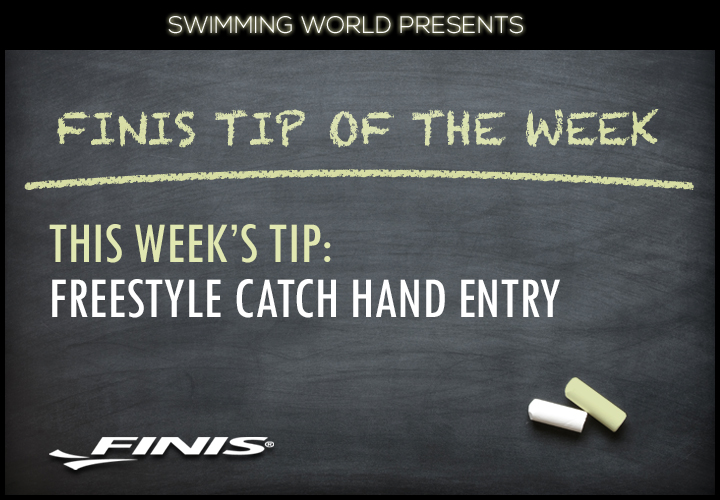FINIS Tip Of The Week: Freestyle Catch Hand Entry

The Tip of the Week is sponsored by FINIS. Visit FINISswim.com for more information about our sponsor.
Welcome to the “FINIS Tip of the Week.” Swimming World will be bringing you a topic that we’ll explore with drills and concepts for you to implement with your team on a regular basis. While certain weeks may be more appropriate for specific levels of swimming (club, high school, college, or masters), each tip is meant to be flexible for your needs and inclusive for all levels of swimming.
This month’s tip series is focused on the all-important freestyle catch. Arguably the most important part of any freestyle, developing and maintaining an efficient freestyle catch is crucial for swimmers at any ability level.
We’ll start this week by looking at the very first phase of having a good catch: the hand entry. While this may seem like a simple stage of the skill (how hard is it to put your hand in the water?) there are a few key points that are useful to remember when thinking about the catch.
Fingertips First…
Swimmers want to enter the water as efficiently as possible to set themselves up for a good catch. With any level of swimmer you want to make sure that the fingertips are entering the water first to set up for a strong hold on the water. Particularly when teaching young or beginning swimmers, watch to make sure swimmers are not “slapping” the water or entering with the pinky or thumb side of their hand, as this will set them up for a less efficient pull later on in the stroke.
Fingertip drag or zipper drill are both easy drills that slow down the stroke and help build swimmers’ awareness of what they are doing with their hands. Video is also a great way to provide feedback to swimmers in this area, as many of them will not realize they may be entering the water incorrectly.
Hand Placement…
Equally important when talking about the hand entry during the catch is to talk about where their hand is entering the water. Everyone’s stroke and hand entry will be slightly different, but regardless of the swimmer you want to make sure that they are entering the water in front of their shoulder and not crossing over the center of their body line. This will ensure that they are in a stable position to get an immediate hold on the water and be moving themselves forward in the water, not at a different angle with each stroke.
Again, any drill that slows down the stroke will help swimmers get a better sense of how to set up correct hand placement. For beginning swimmers, six kick switch is a great way to isolate a single stroke at a time and help them become more aware of their movements, as is 3-6-3 DPS or catch up eleven. You can also play around with “slow motion” swimming to see how exactly swimmers are entering the water and challenge them to correct it in real time. Happy swimming!





Nothing like losing momentum from the drag and zip drills to learn what the hands are not doing during the recovery. Avoid these lag and grip drills as they have no relation to swimming fast.